Late in the season, much of the color fades away in our gardens, outdoor plants stop flowering, and many drop their leaves. But if you miss those gorgeous flower colors in mid-winter, there is a simple way that you can continue to enjoy homegrown fresh flowers at any time of the year. All you need to do is redirect your green thumb indoors and grow winter-blooming houseplants!
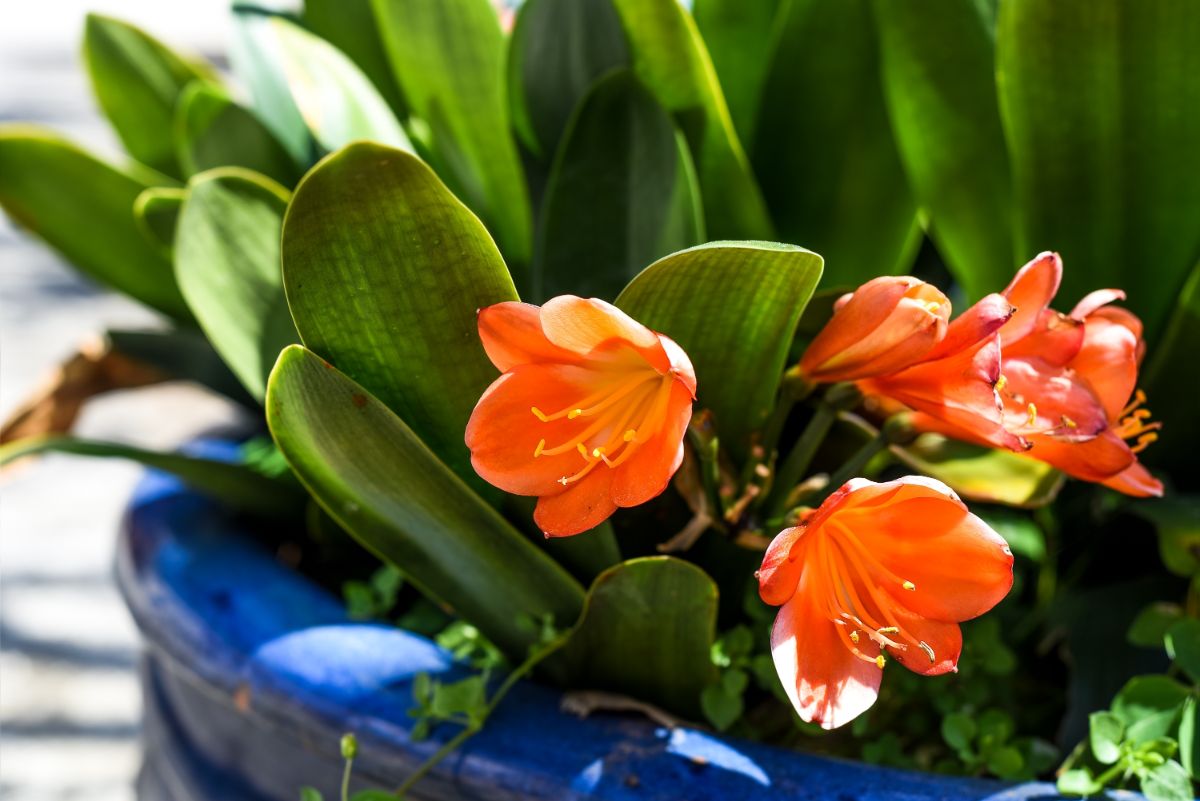
Many plants flower according to the amount of light they receive, but plants that bloom in winter are often triggered to flower by shorter day lengths. That’s great news if short winter days have you blue. When nights are long, and the sun fades early, resilient, winter-blooming houseplants come alive with festive flowers in almost any shape and color you could want!
Jump to:
- 16 flowering houseplants that bloom in winter
- 1. African violet (Saintpaulia Ionantha)
- 2. Crown of thorns (Euphorbia milii)
- 3. Moth orchid (Phalaenopsis spp.)
- 4. Cyclamen (Cyclamen persicum)
- 5. Christmas cactus (Schlumbergera bridgesii)
- 6. ‘Widow’s Thrill’ kalanchoe (Kalanchoe blossfeldiana)
- 7. Flamingo lily (Anthurium andraeanum)
- 8. Amaryllis (Hippeastrum spp.)
- 9. Begonia (Begonia spp.)
- 10. Desert rose (Adenium obesum)
- 11. Clivia (Clivia miniata)
- 12. Lipstick plant (Aeschynanthus spp.)
- 13. Poinsettia (Euphorbia pulcherrima)
- 14. Bromeliad (Bromeliaceae spp.)
- 15. Hawaiian wedding vine (Stephanotis floribunda)
- 16. Paperwhite (Narcissus papyraceus)
- Frequently asked questions
- What is the longest-blooming indoor flower?
- How do I keep my amaryllis bulb for next year?
- When should I throw away my amaryllis?
- How do I save my Paperwhites for next year?
- How do you keep a poinsettia alive in the summer?
- Why is my indoor plant not flowering?
- Summary
16 flowering houseplants that bloom in winter
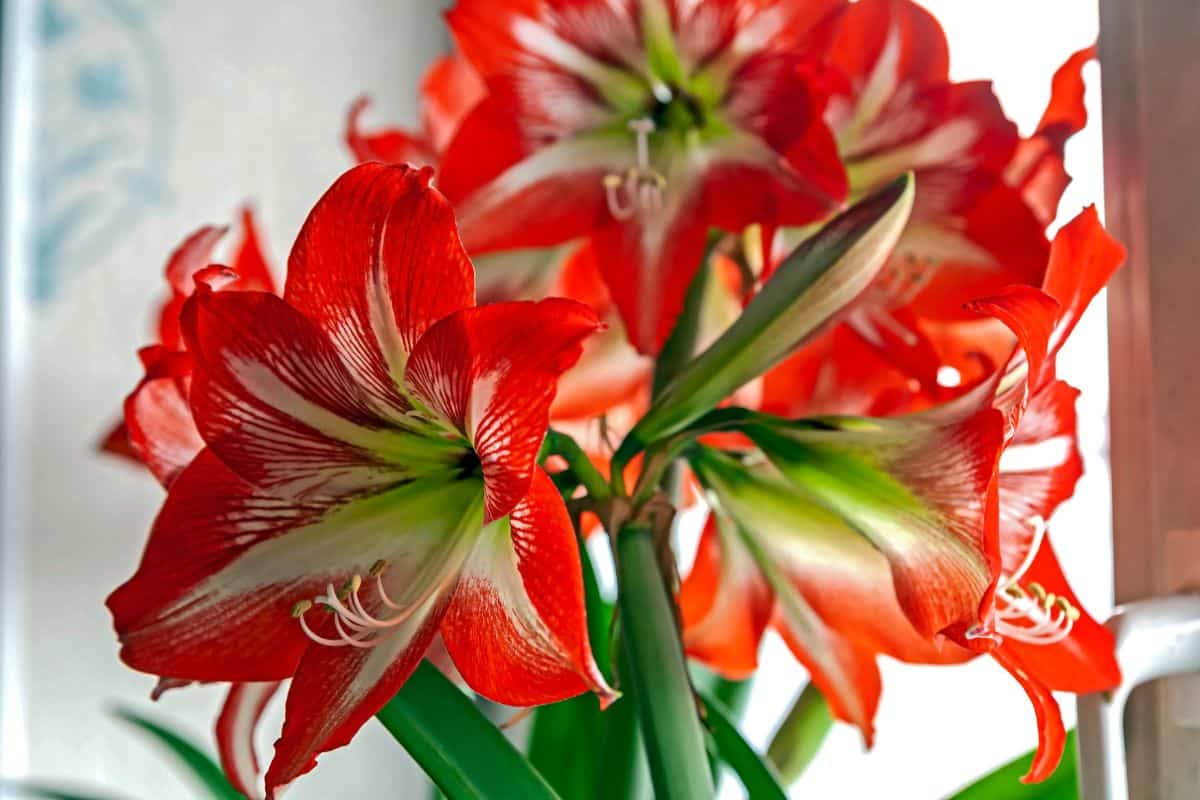
Winter-blooming houseplants can be grown simply for their stunning, cool season blooms. But plants that flower in winter also make exceptional gifts, and they can even be used as decorations around the holidays! Below, you’ll discover houseplants of all shapes, colors, and growing experience levels to suit any indoor gardener’s needs.
1. African violet (Saintpaulia Ionantha)
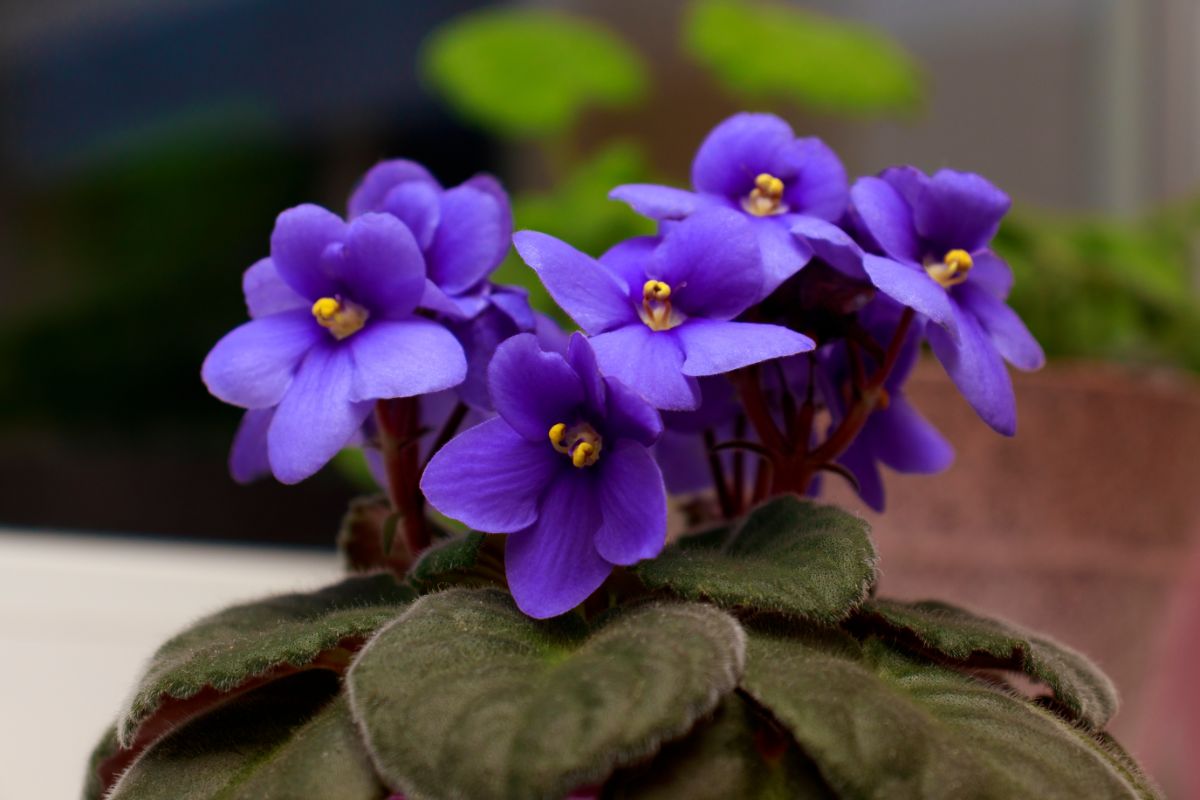
| Plant name: | African violet |
| Light needs: | Bright, indirect light |
| Water needs: | Moderate |
| Toxic to pets? | No |
African violets are one of the easiest houseplants to recognize, thanks to their furry and rounded leaves. But African violets are also prized for their long-lasting flowers that come in tons of different colors, including pink, purple, white, and bicolored blooms. These easygoing plants can bloom continuously throughout the winter months, and they flower sporadically at other times of the year as well.
African violets don’t need a lot of extra fuss, but they don’t like getting their leaves wet. If you want to keep your plants happy, always water African violets at the soil line and avoid splashing water droplets on their leaves if you can help it. For even better results, try potting up your plants in violet pots and use a potting mix and fertilizer that is specially designed to suit the needs of African violets.
2. Crown of thorns (Euphorbia milii)
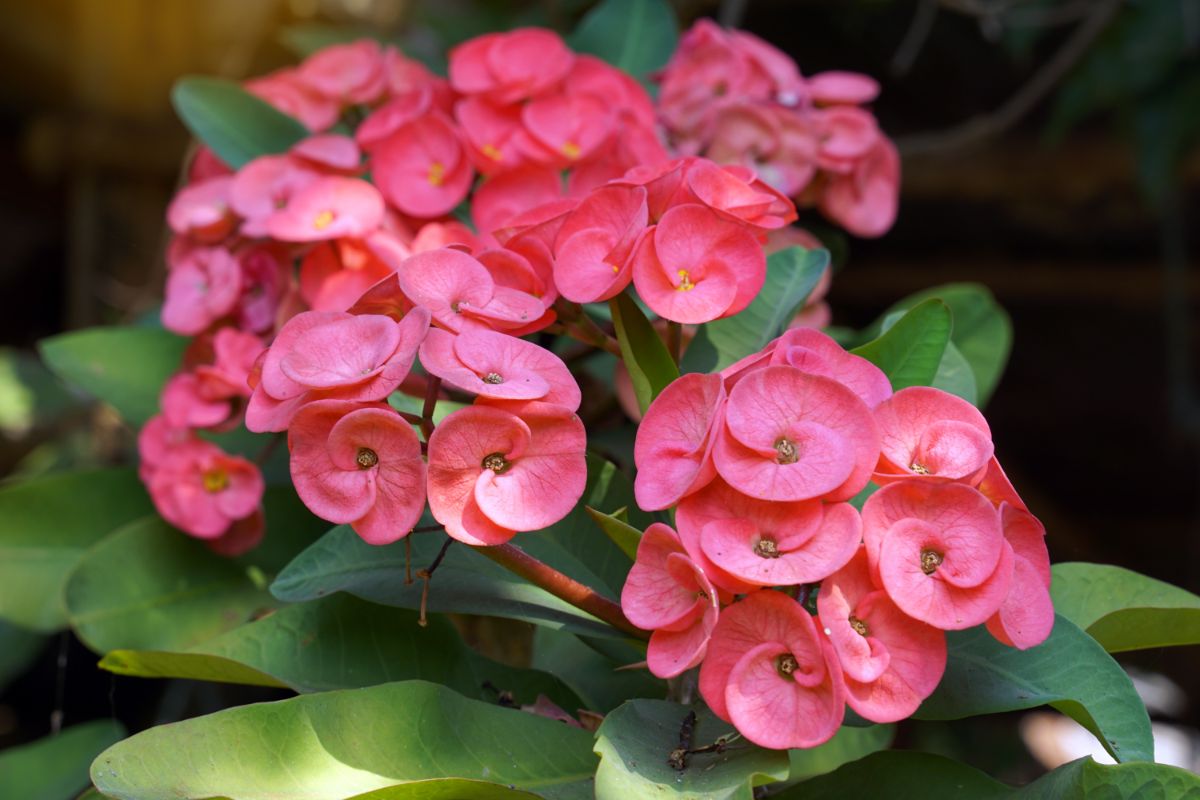
| Plant name: | Crown of thorns |
| Light needs: | Bright light |
| Water needs: | Moderate |
| Toxic to pets? | Yes |
Crown of thorns is an interesting plant with unique, rounded flowers that come in shades of pink, red, or white. Beyond those bright flowers, crown of thorns plants have rounded leaves and thorny stems that make them stand out in houseplant collections. Plus, they bloom almost all year round, just as long as they get at least 3 to 4 hours of light daily.
Like their close relative, the African milk tree, crown of thorns plants are toxic if ingested, so you will want to keep them out of the reach of pets and small children. Crown of thorns plants are technically succulents, and they don’t need lots of water, but they will grow best if they’re provided with about 1” of water per week. If these plants aren’t watered enough, they can start to drop some of their leaves, although crown of thorns plants will naturally drop their lower leaves as they age as well.
3. Moth orchid (Phalaenopsis spp.)
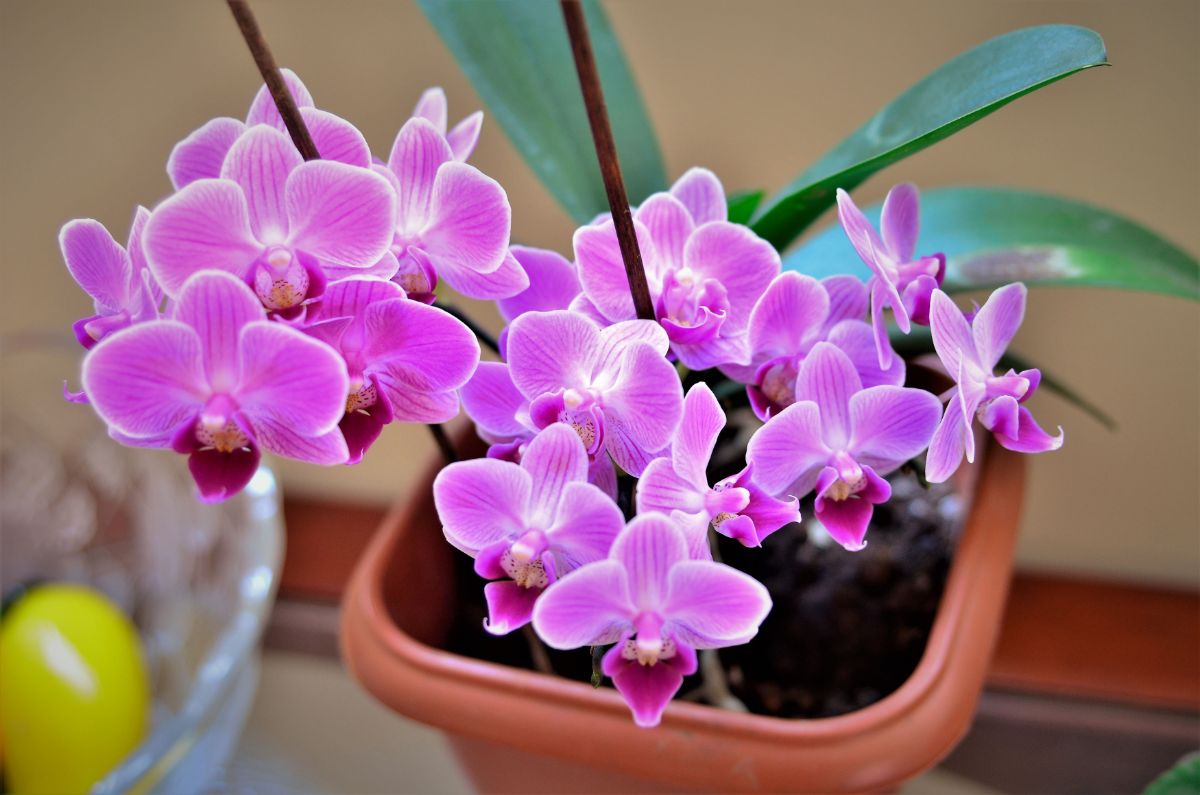
| Plant name: | Moth orchid |
| Light needs: | Bright, indirect light |
| Water needs: | Moderate |
| Toxic to pets? | No |
Moth orchids are the most common type of orchids cultivated among home growers, and you’ll find them for sale at local nurseries and grocery stores. Moth orchids have long-lasting and showy blooms that come in a rainbow of colors, including pink, purple, and white, and many moth orchid flowers also feature colorful speckling patterns that only add to their allure. Most of the time, moth orchids will flower from late winter to spring, but well-maintained plants may bloom every 3 months if you’re lucky.
Once moth orchids flower, blooms typically last for 2 to 6 months, and then the flowers fade away while the plant is in a state of rest. During this time, it’s wise to repot your orchids if they’re still in their original nursery growing container and clip back the old flower spike to encourage future flowering. You can also sometimes trick orchids into flowering again by exposing them to cool nighttime temperatures between 55 and 65F.
4. Cyclamen (Cyclamen persicum)
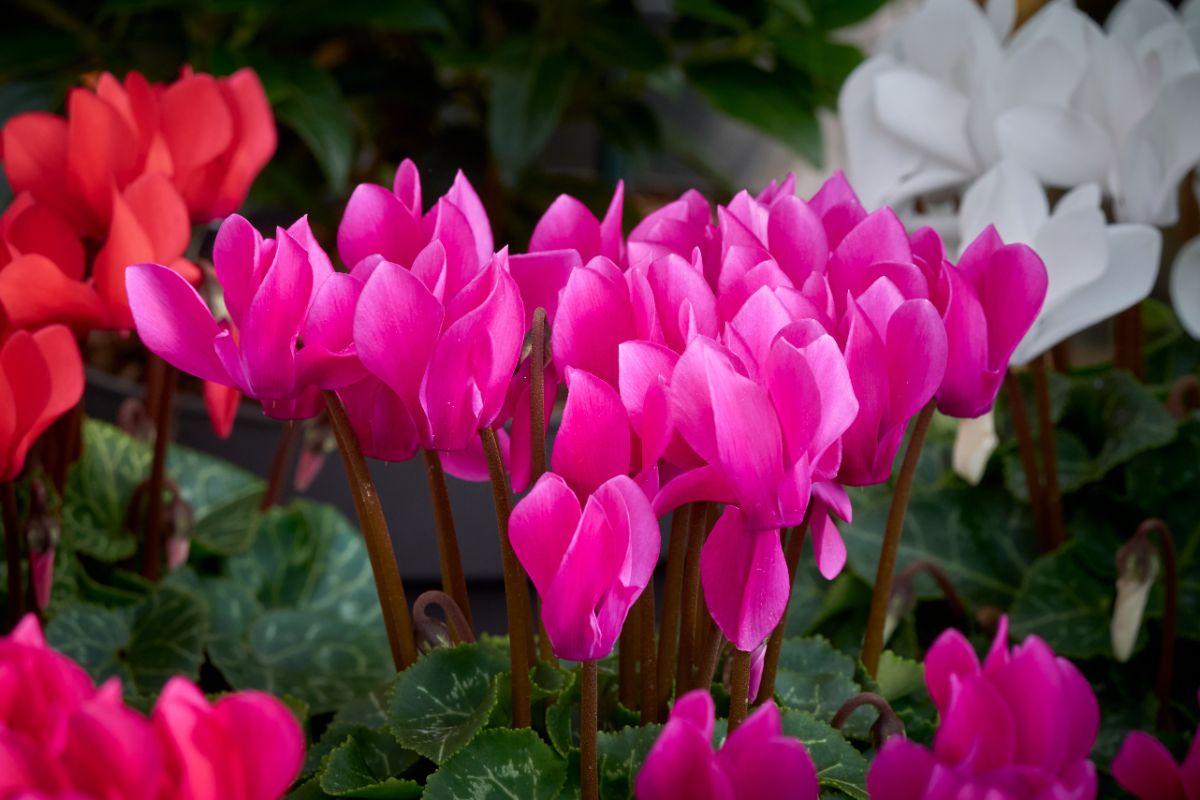
| Plant name: | Cyclamen |
| Light needs: | Bright, indirect light |
| Water needs: | Moderate to low |
| Toxic to pets? | Yes |
Cyclamen are native to the Mediterranean region, and they have a super long bloom time that can last from fall to spring. When they bloom in winter, cyclamen produce a flashy display of red, white, and pink flowers that have an unusual, downward-facing shape. But although many growers keep cyclamen solely for their blooms, these plants also produce variegated, heart-shaped leaves that are plenty attractive on their own.
After flowering, cyclamen plants usually enter into a state of dormancy, which allows the plant to recover some energy. However, when this occurs, cyclamens can drop their leaves and flowers, and many indoor gardeners mistake this dormant state for plant death. However, if your plant’s bulb is still nice and firm and doesn’t have any mushy spots, there’s a good chance that your cyclamen is just dormant, and it will bloom again in no time!
5. Christmas cactus (Schlumbergera bridgesii)
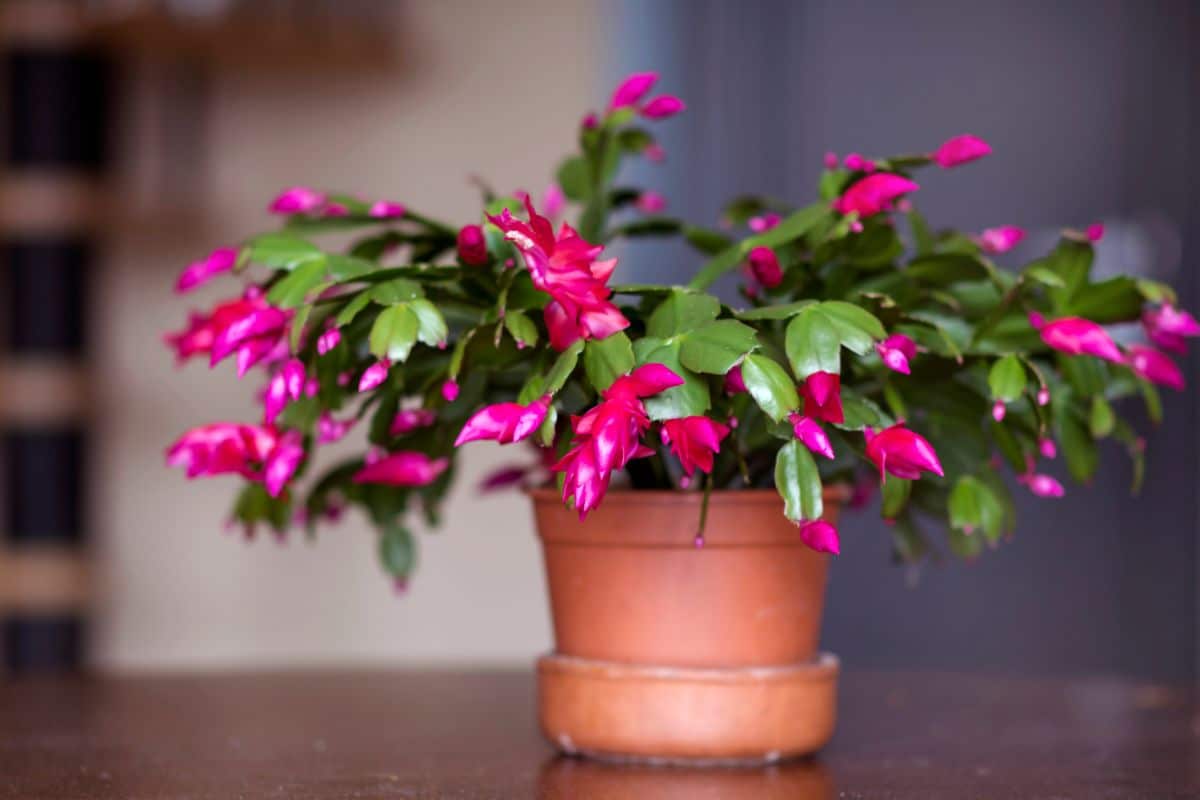
| Plant name: | Christmas cactus |
| Light needs: | Bright, indirect light |
| Water needs: | Low |
| Toxic to pets? | No |
Christmas cacti are often confused with Thanksgiving and Easter cacti; however, these plants have different flower colors and leaf shapes. Plus, these plants bloom at different times of the year, and if you’re on the hunt for houseplants that bloom in winter, Christmas cacti are the plants you want to get your hands on. These tough beauties bloom during the winter months, just in time for the holiday season!
Christmas cacti have tropical-looking, layered flowers that typically come in either purple or pink. Aside from their flashy blooms, these plants also produce long, cascading stems that are composed of fleshy and segmented leaves. If you want to easily propagate Christmas cactus plants, all you need to do is place a section of the plant’s stem into some moist soil or water and wait for it to root!
6. ‘Widow’s Thrill’ kalanchoe (Kalanchoe blossfeldiana)
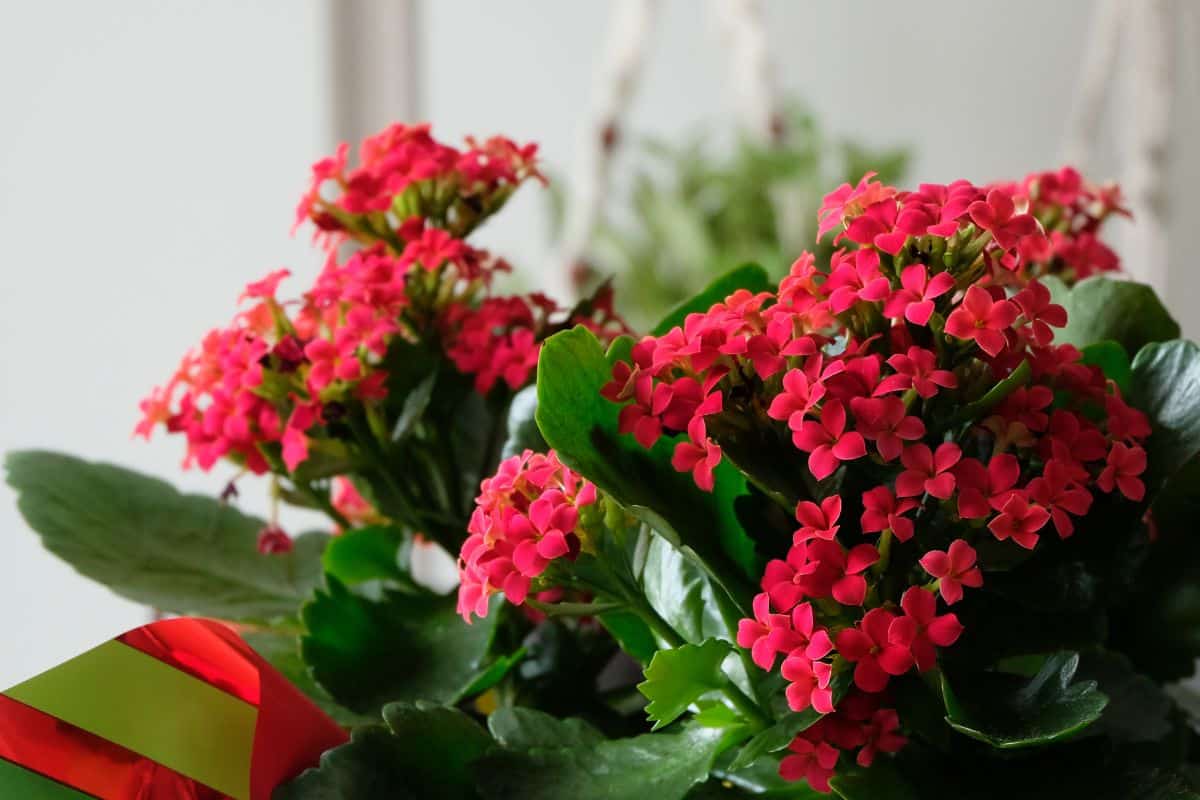
| Plant name: | ‘Widow’s Thrill’ kalanchoe |
| Light needs: | Bright light to bright, indirect light |
| Water needs: | Low |
| Toxic to pets? | Yes |
There are about 125 different types of kalanchoe plants, but ‘Widow’s Thrill’ is one of the easiest to find and most colorful varieties. Also known as the florist’s kalanchoe, ‘Widow’s Thrill’ plants bloom in late winter to early spring, and their flowers can last for months. Blooms come in almost any shade you can imagine, and the sheer abundance of ‘Widow’s Thrill’ flowers is the perfect remedy for gloomy winter weather!
Like other succulents, ‘Widow’s Thrill’ doesn’t need a lot of water, but it does crave a bit more moisture than some other succulent species. These plants will grow best if they’re watered when the top 2” of soil feels dry to the touch. They also prefer to grow in well-draining potting mixes that are specially formulated for succulents, as ‘Widow’s Thrill’ plants can develop root rot if they’re grown in soggy soil.
7. Flamingo lily (Anthurium andraeanum)
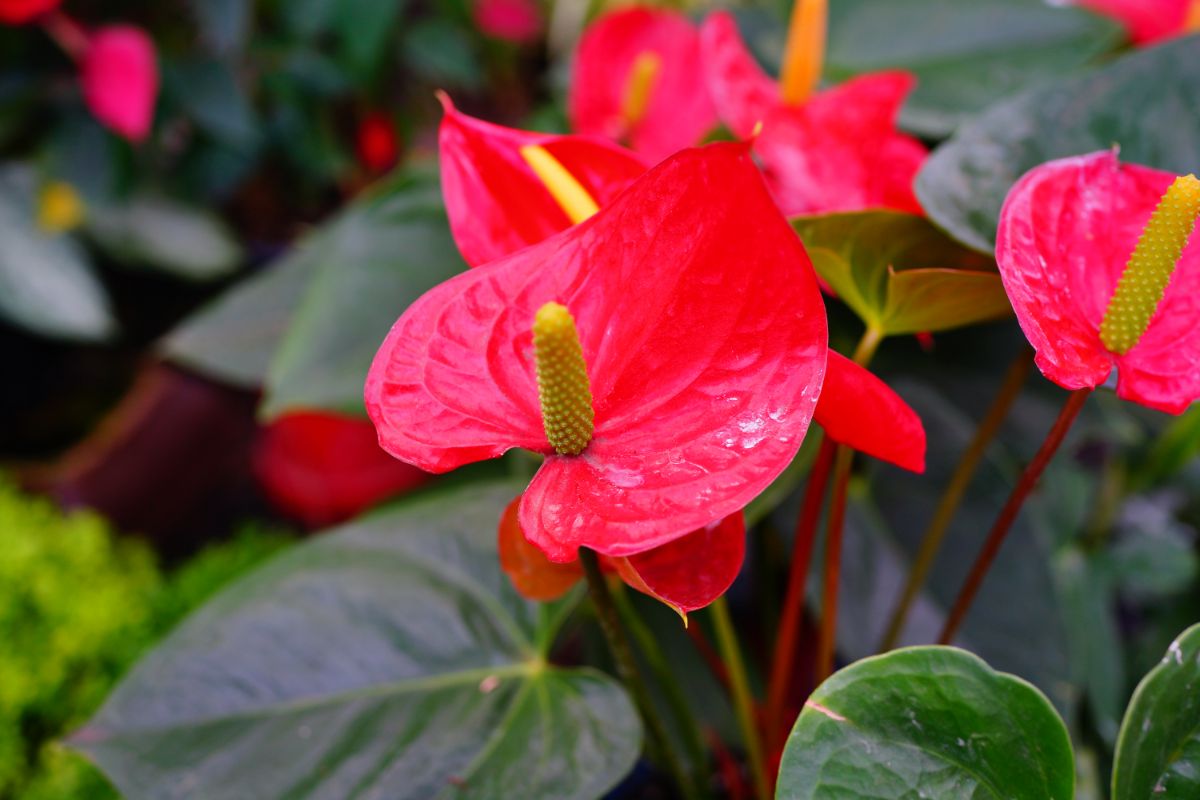
| Plant name: | Flamingo lily |
| Light needs: | Bright, indirect light |
| Water needs: | High |
| Toxic to pets? | Yes |
Aptly named flamingo lilies have a bright and tropical look that adds much-needed color to houseplant shelves during the dark winter months. Interestingly, flamingo lily’s bright “flowers” aren’t flowers at all; and they’re actually modified leaf structures called spathes. Flamingo lilies’ true flowers are much, much smaller, and they appear in clusters around the exterior of fleshy flower spikes, which protrude from the plant’s colorful spathes.
While flamingo lilies can bloom throughout the year when they’re cared for well, they will flower best if they are allowed to rest on occasion in a state of dormancy. Like orchids, flamingo lilies are epiphytes, and they grow on trees in the wild. In homes, flamingo lilies certainly don’t need to scramble up trees to grow, but they should be potted in a well-draining potting mix that’s suitable for orchids to make sure they don’t sit in too much water.
8. Amaryllis (Hippeastrum spp.)

| Plant name: | Amaryllis |
| Light needs: | Bright light |
| Water needs: | Moderate |
| Toxic to pets? | Yes |
One of the most famous plants around the holidays, amaryllis bulbs are often given as Christmas gifts. But once you see how stunning amaryllis plants can be, you may prefer to keep amaryllis bulbs for yourself and not give them away to your friends. Unlike many houseplants, amaryllis plants have an incredibly long bloom time, and they often flower from December to June!
Although amaryllis’ trumpet-shaped flowers bear a close resemblance to lily flowers, these plants are only distantly related to lilies. However, like lilies, amaryllis plants are toxic to pets, so they may not be the best choice for homes with cats and dogs. One great thing about amaryllis bulbs is that they can be grown in gravel, soil, or water, depending on your gardening style!
9. Begonia (Begonia spp.)
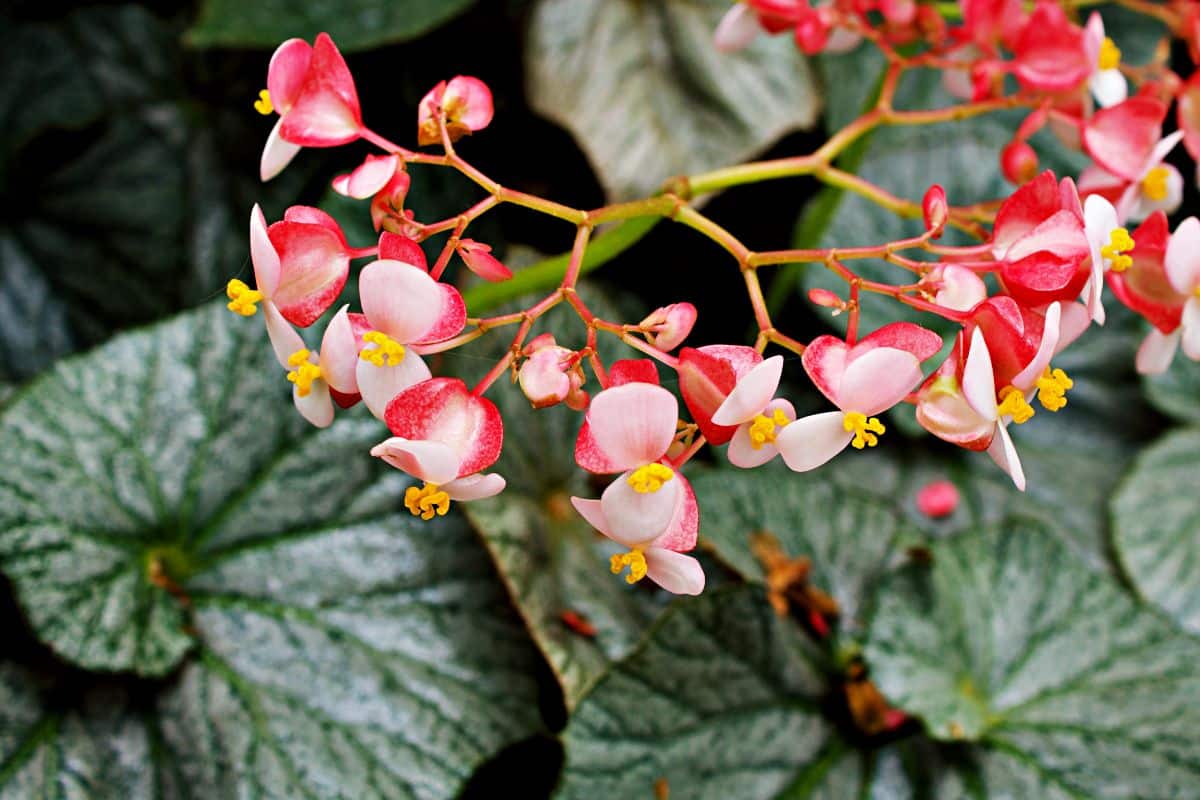
| Plant name: | Begonia |
| Light needs: | Bright, indirect light |
| Water needs: | Moderate |
| Toxic to pets? | Yes |
Begonias belong to a very large plant family that contains over 2000 different species. Some begonias produce long, bamboo-like canes, which gives these plants a dramatic look and lends vertical interest to houseplant collections. Other rhizomatous begonias are more compact growers that fit easily on windowsills and houseplant shelves, although some of these plants are mostly cultivated for their leaves, not their flowers.
If you’re looking for plants that bloom in winter, there are a few excellent options in the begonia plant family. Some of the best choices for late-season flowers include ‘Palomar Prince,’ ‘Black Coffee’ and ‘River Nile.’ In general, begonias are beginner-friendly plants, but they should be shielded from intense sun as direct light can sometimes scorch their delicate leaves.
10. Desert rose (Adenium obesum)
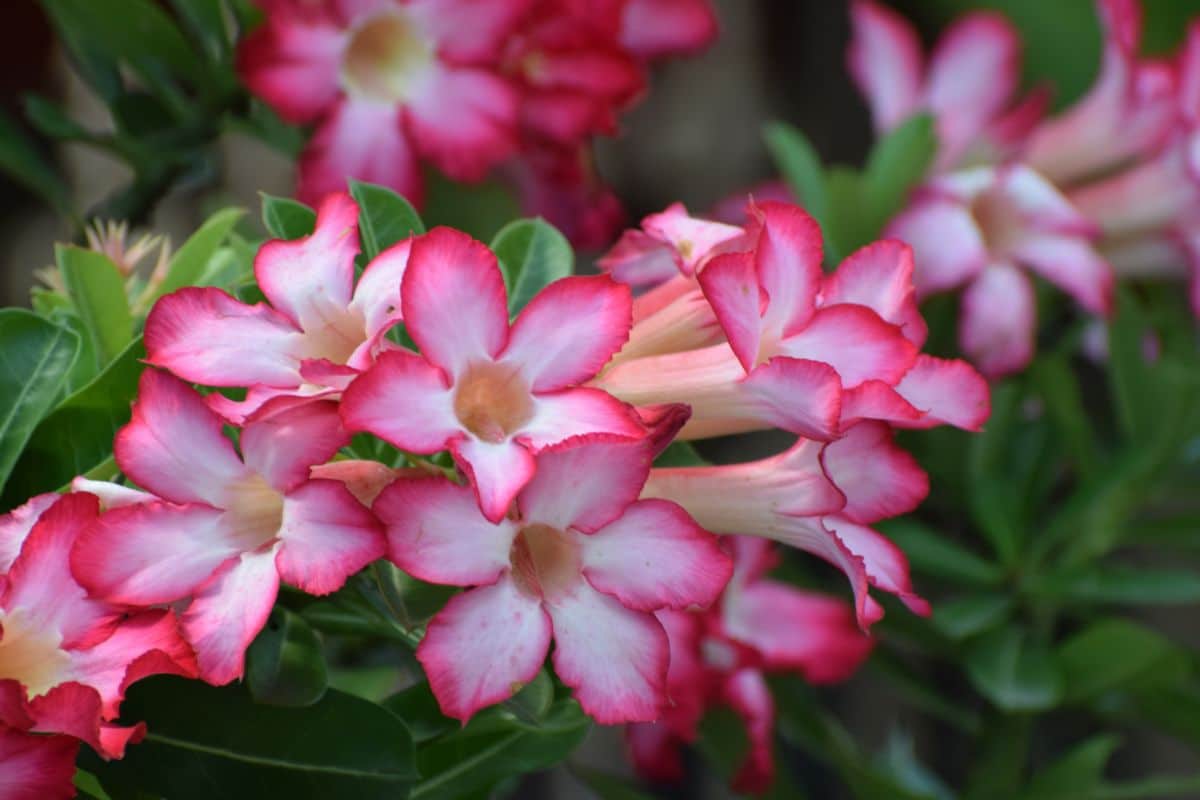
| Plant name: | Desert rose |
| Light needs: | Bright, indirect light |
| Water needs: | Low |
| Toxic to pets? | Yes |
Desert rose plants have a strong silhouette thanks to their thick, succulent trunks. Plants use this fleshy trunk to store moisture and resist drought, which is why desert rose plants rarely need to be watered. Like other succulent plants, desert roses should be grown in rocky or sandy potting mixes intended for succulents, and they should be allowed to dry out a bit in between waterings.
Relatively slow growers, desert rose plants only grow about 12” a year under ideal conditions, and plants max out at around 3 to 9’ tall. In warm areas, desert roses can be grown outdoors as landscaping plants; however, they don’t tolerate frost, so plants will do better as houseplants in cool areas. Mature desert rose plants generally bloom in late winter to early spring, and their delicate pink and red flowers provide an interesting contrast to the plant’s thick stems.
11. Clivia (Clivia miniata)
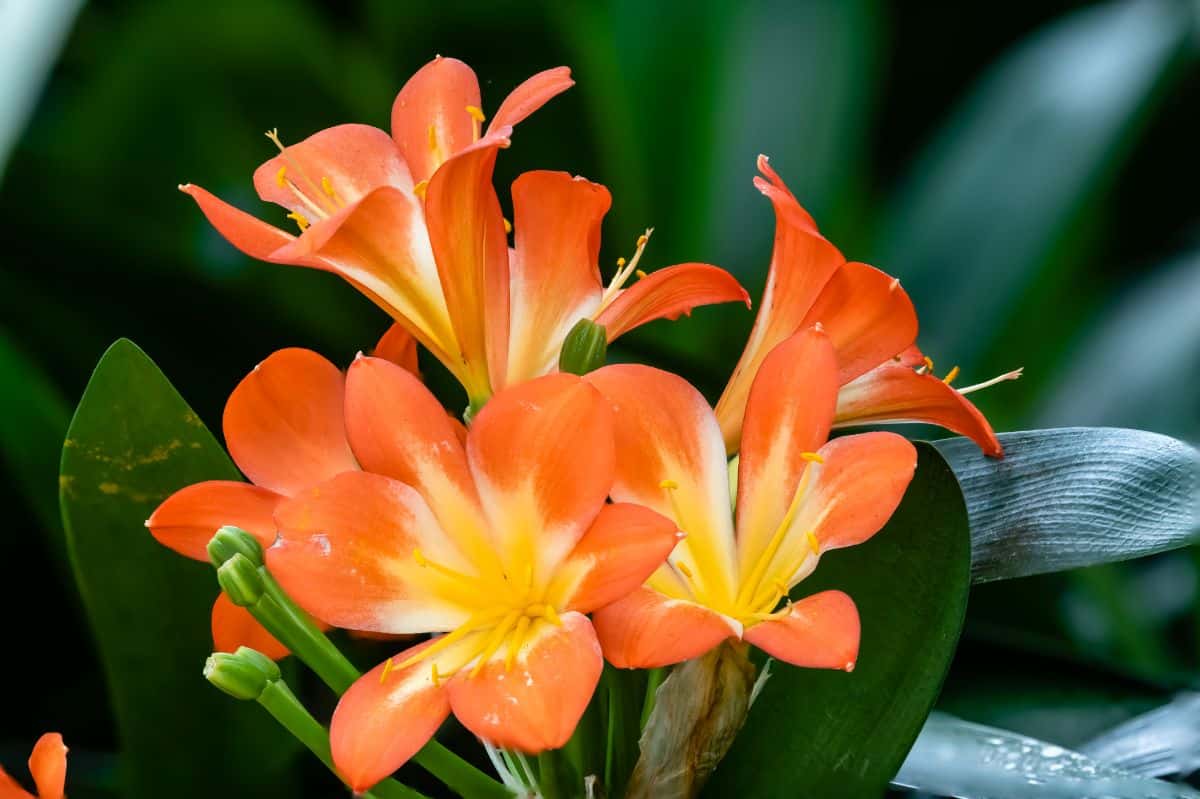
| Plant name: | Clivia |
| Light needs: | Bright, indirect light |
| Water needs: | Low |
| Toxic to pets? | Yes |
Also known as the Natal lily or bush lily, clivia plants have a similar look and feel to amaryllis, although these plants often have orange flowers and they keep their leaves throughout the year. When in bloom, clivia exudes a rich fragrance, which makes them a treat to the eyes as well as the nose! However, these plants can be hard to track down, and due to their rarity, they can be a bit pricey too.
Like amaryllis, clivia plants are toxic to pets, so you’ll want to keep these plants far away from your furry friends. Clivia plants prefer to grow in bright, indirect light, and they need to rest in the fall to trigger winter blooming. For proper maintenance, allow clivia’s soil to dry out slightly in between waterings and fertilize your plants about once a month during their growing season.
12. Lipstick plant (Aeschynanthus spp.)
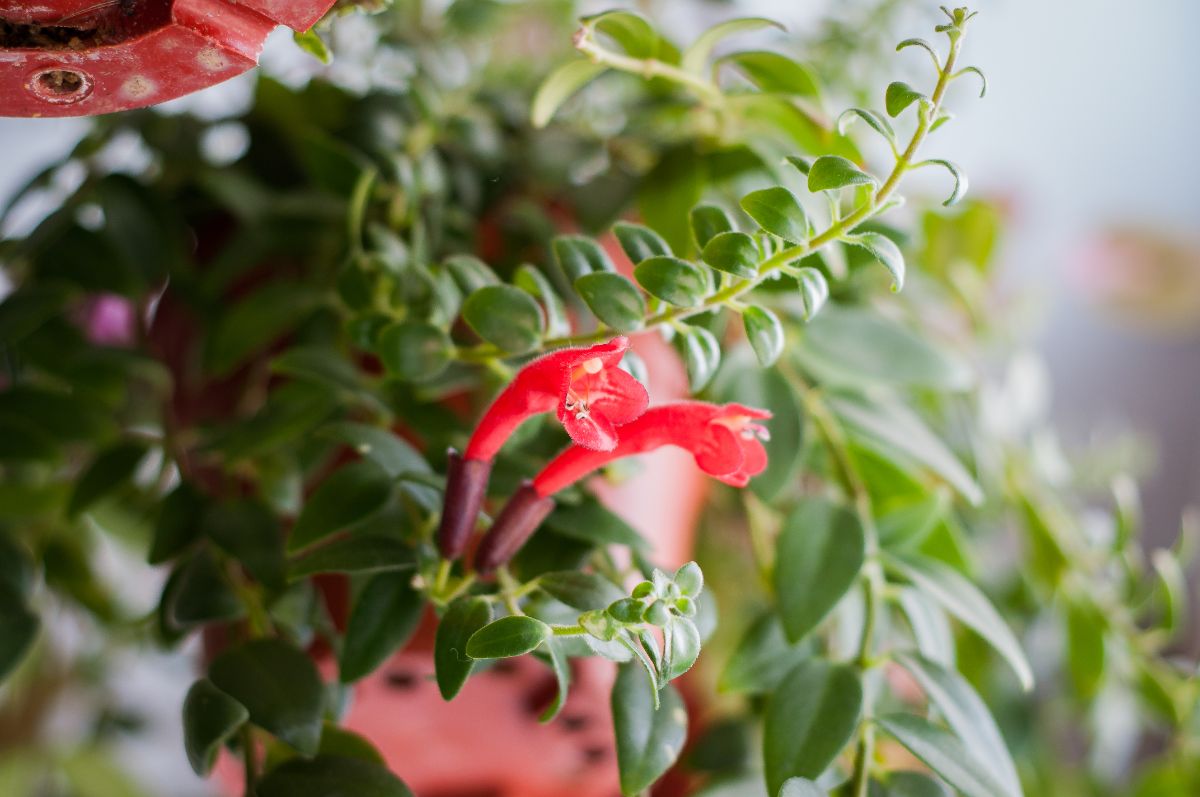
| Plant name: | Lipstick plant |
| Light needs: | Bright, indirect light |
| Water needs: | Moderate |
| Toxic to pets? | No |
Take one look at the lipstick plant, and you can easily guess where this unusual beauty got its name. Lipstick plants produce bright red, tubular flowers, which are said to look a lot like tubes of lipstick. Those flowers can appear at any time of the year, and they’re most common in spring and summer… but lipstick plants will sometimes flower in winter as well.
Due to their trailing growth habit, lipstick plants are often grown in hanging pots and baskets, although their cascading stems also display well on high houseplant shelves. In the wild, lipstick plants grow as epiphytes, and they will need to be kept in a well-draining potting mix when they’re grown indoors in order to prevent soggy roots. Plants also grow best in bright, indirect light, and they should be fertilized regularly with a diluted, liquid fertilizer during the growing season to support their growth and flowering.
13. Poinsettia (Euphorbia pulcherrima)
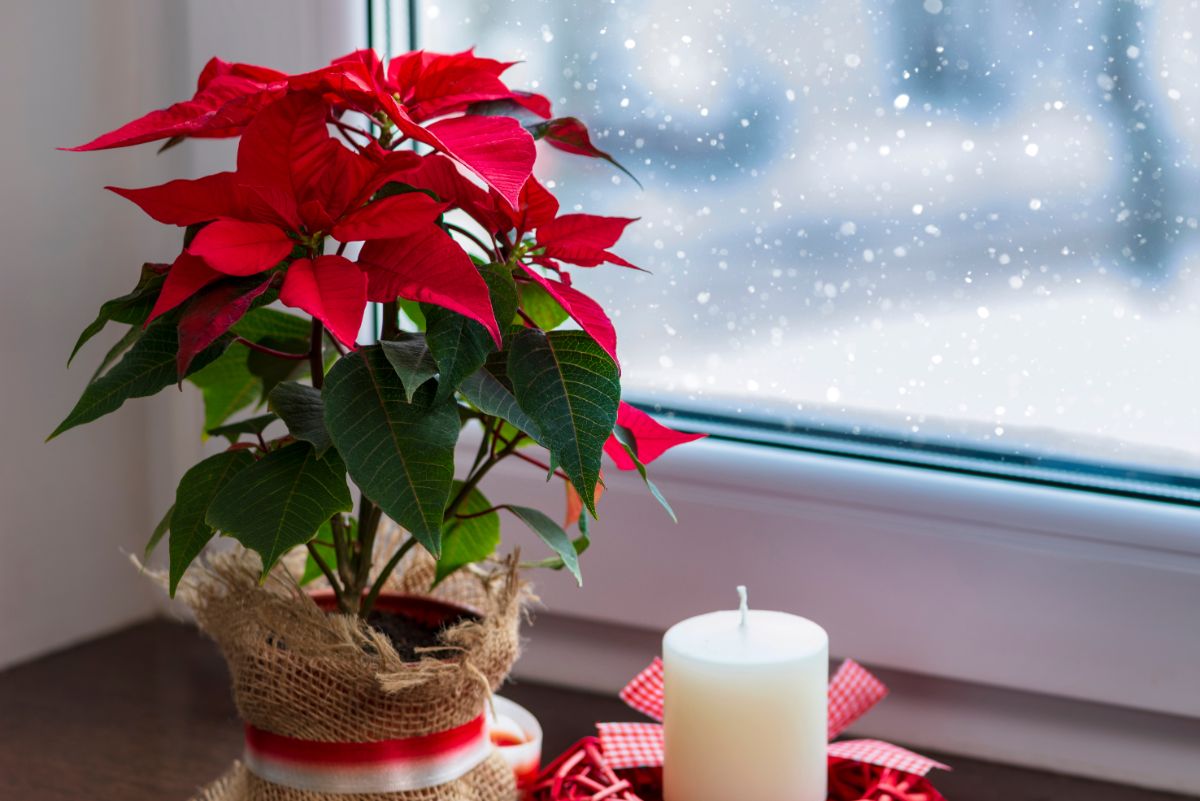
| Plant name: | Poinsettia |
| Light needs: | Bright, indirect light |
| Water needs: | Moderate |
| Toxic to pets? | Yes |
Arguably the most recognizable potted plant around the holiday season, poinsettia are commonly sold as Christmas décor, but these plants can be kept as houseplants year round, too. Poinsettia boasts bright red or white bracts, which many people believe are the plant’s flowers. However, like the spathes on flamingo lilies, poinsettia bracts are actually modified leaf structures, and they aren’t flowers at all!
Poinsettia are native to Mexico and Guatemala, where they can be found growing wild in rocky canyons and other well-draining spots. In homes, poinsettia should be kept in bright, indirect light, and they should be protected from A/C units and heaters, which can make plants dry out too quickly. Indoors, poinsettia can suffer from low humidity, and you may want to consider keeping your plants on pebble trays or near a humidifier to prevent plants from developing brown or crispy leaves.
14. Bromeliad (Bromeliaceae spp.)
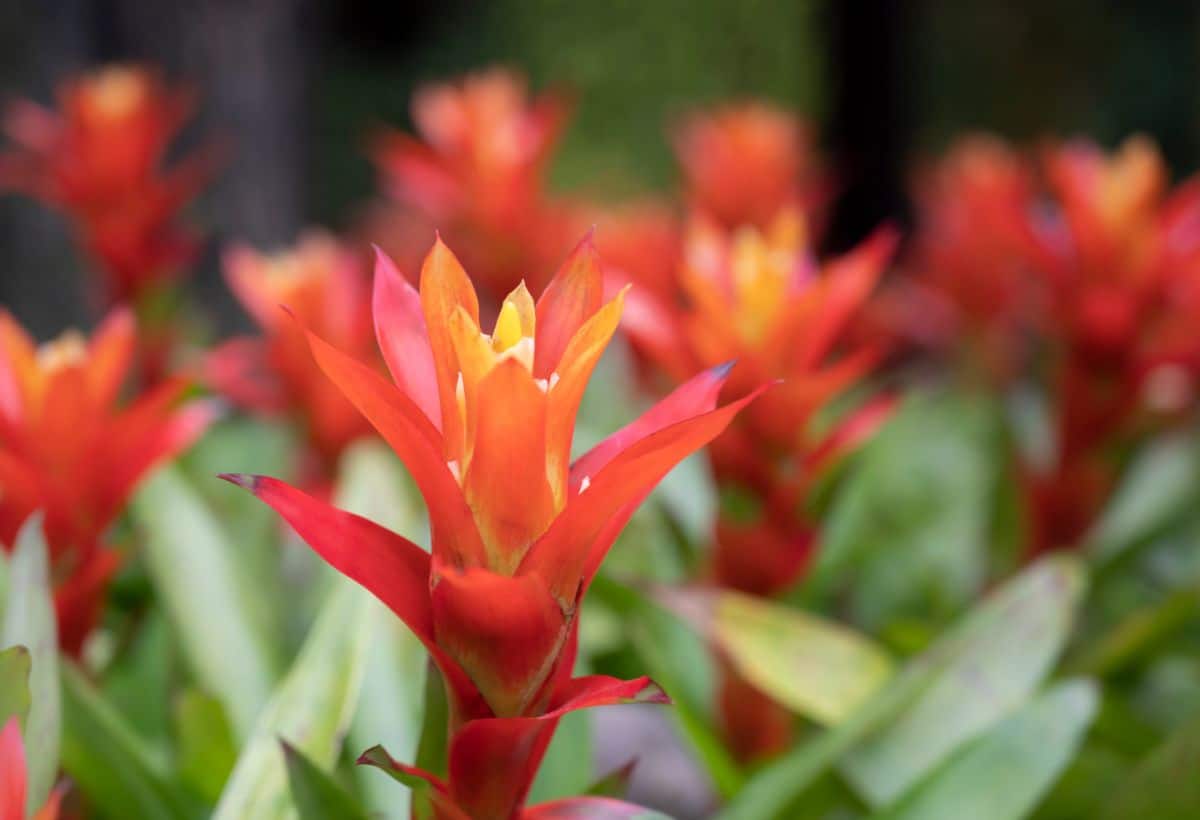
| Plant name: | Bromeliad |
| Light needs: | Depends on species |
| Water needs: | Moderate to low |
| Toxic to pets? | No |
Yet another epiphyte plant, wild bromeliads, can be found growing in crevasses in rocks and crooks in tree branches. In homes, bromeliads look enchanting when they’re placed in pots or hanging baskets, but they should be planted in a well-draining potting mix intended for orchids. Today, there are many bromeliad species available to home growers, and many of these plants will flower year-round.
One thing to keep in mind with bromeliads is that most bromeliad species are monocarps, which means they only bloom once in their lifetimes. When they bloom, bromeliads can’t help but hold one’s attention with their tall and colorful flowers that look like miniature fireworks and come in shades of pink, yellow, orange, and red. After they’re done flowering, mature bromeliads will typically die away, but they will often sprout new bromeliad babies, or pups, before they do!
15. Hawaiian wedding vine (Stephanotis floribunda)

| Plant name: | Hawaiian wedding vine |
| Light needs: | Bright light |
| Water needs: | High |
| Toxic to pets? | No |
Also known as the bridal flower or Madagascar jasmine, Hawaiian wedding vines aren’t as commonly grown as some of the other plants on this list, but they have lots to recommend them. Since they’re harder to find, you may not be able to track down Hawaiian wedding vine plants at your local plant nursery, but you can usually order them online. Much coveted for their glossy leaves and fragrant, white flowers, Hawaiian wedding vines grow to about 3 to 4’ tall when kept indoors, but they can get much larger in areas where they grow outside as perennials.
Preferring well-draining, acidic soils, Hawaiian wedding vines grow best in full sun, and plants won’t flower as abundantly in lower-light areas. Most often, these plants bloom in spring or summer, but they can flower year-round when they’re provided with everything they need. Like other climbers, Hawaiian wedding vines will usually need a trellis or moss pole to grow up, but plants can also be kept in hanging baskets.
16. Paperwhite (Narcissus papyraceus)
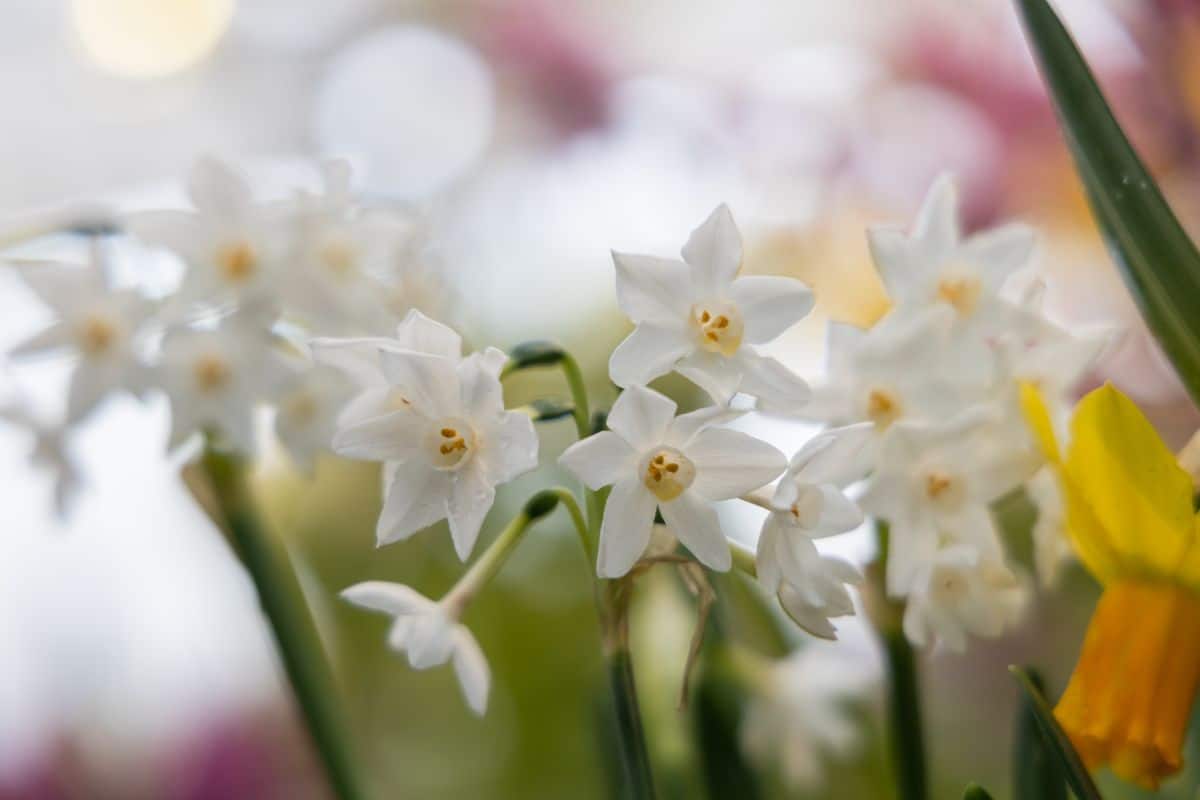
| Plant name: | Paperwhite |
| Light needs: | Bright light |
| Water needs: | Moderate |
| Toxic to pets? | Yes |
Like amaryllis, paperwhites are often sold around the holidays, and they make festive gifts for friends and family. Depending on your style, you can also use paperwhites to decorate your home and ornament your holiday table too. A close relative of daffodils, paperwhites are native to the Mediterranean region, and they’re typically sold as bulbs, although you can sometimes find started plants for sale as well.
Growing paperwhites from bulbs isn’t difficult, and it doesn’t take much time. Bulbs don’t need to be chilled before planting, and they will often flower in just 2 to 8 weeks after you plant them. Like amaryllis, paperwhites don’t need soil to grow, and they can flower beautifully when planted in gravel or glass pebbles, but they are toxic to pets!
Frequently asked questions
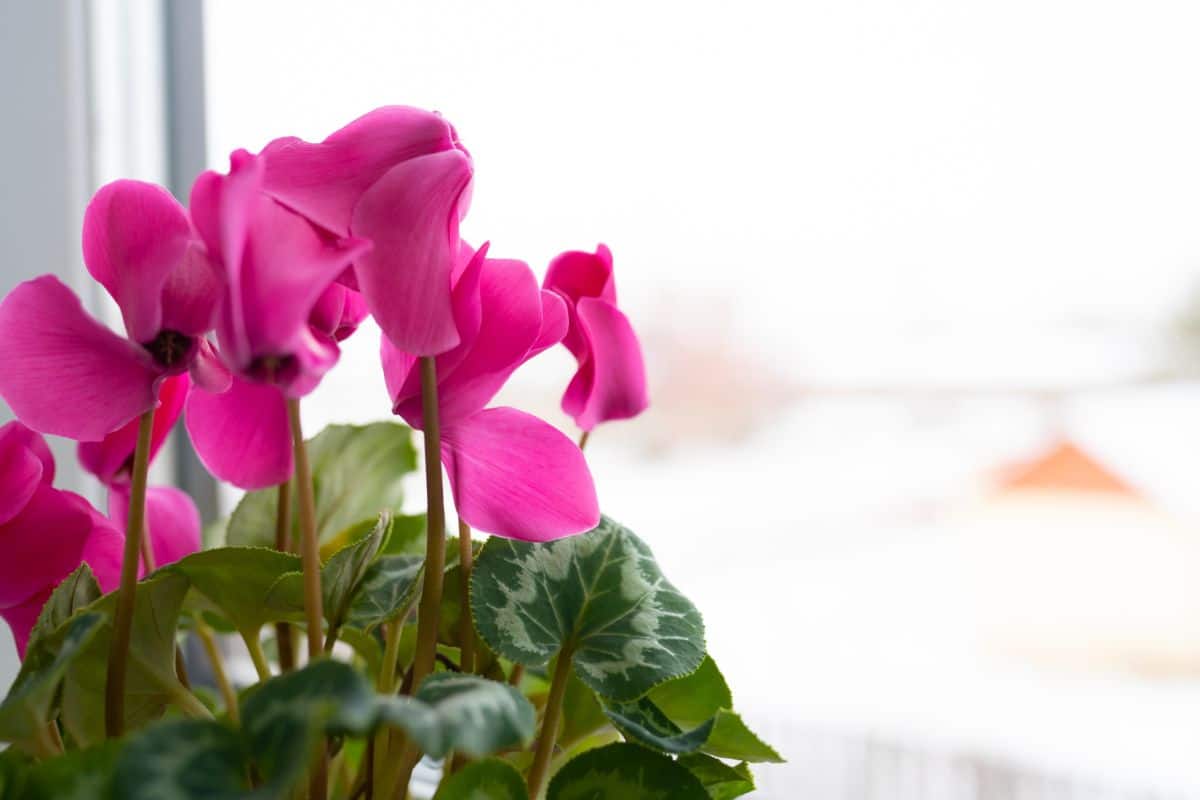
What is the longest-blooming indoor flower?
Flamingo lilies and moth orchids can keep their flowers for months, as can crown of thorns plants, and cyclamens. If you’re looking for plants that will add color to your home during the winter months, these long-blooming beauties are hard to beat!
How do I keep my amaryllis bulb for next year?
Many growers throw out amaryllis bulbs after they’re done flowering, but this isn’t necessary. Amaryllis plants will bloom again and again if you remove the plant from its pot and allow it to dry out. After that, simply store your amaryllis bulbs in a cool, dry, and light-free location until you’re ready to plant them again.
When should I throw away my amaryllis?
Most of the time, amaryllis bulbs can be saved and planted again. However, if your bulbs have started to change colors and turn mushy, they’re unlikely to regrow. In this instance, it’s best to chuck your old amaryllis bulbs in your compost bin and start over with fresh bulbs next year.
How do I save my Paperwhites for next year?
Like amaryllis, paperwhite bulbs can be preserved and planted again next year. All you need to do is remove the bulbs from their growing medium, let them dry out a bit, and then store the bulbs in a cool, dry place that’s out of direct sunlight.
How do you keep a poinsettia alive in the summer?
Although poinsettia is often treated as seasonal décor and thrown away after the holidays, you can keep poinsettia growing all year round if you want to. Plants will need to be watered regularly and kept in bright, indirect light. Poinsettia also craves humidity, so consider placing your plants on pebble trays to boost ambient humidity levels.
Why is my indoor plant not flowering?
You can expect certain houseplants to flower at certain types of the year, but if those flowers are not forthcoming, you may need to adjust your plant care regimen. Often, plants don’t flower because they aren’t receiving enough light, but plants may also not bloom if they’re stressed, under-fertilized, or being preyed on by pests. Check your plants over carefully to determine what’s ailing them, and adjust your plant’s light, watering, and fertilizer schedules accordingly.
Summary

Say goodbye to drab winter days and welcome color back into your home with winter-blooming plants. The festive plants we’ve covered today can be used as holiday décor or given as gifts, but they will also make spectacular additions to your year-round houseplant collection. If you already have houseplants that bloom spring through fall, try out some of these cool-season beauties and keep flowers in your home in any season!
If you love houseplants but don’t want to worry about maintaining flowers, you may also enjoy our guides on houseplants with striking foliage, including indoor plants with furry leaves and striped leaves!

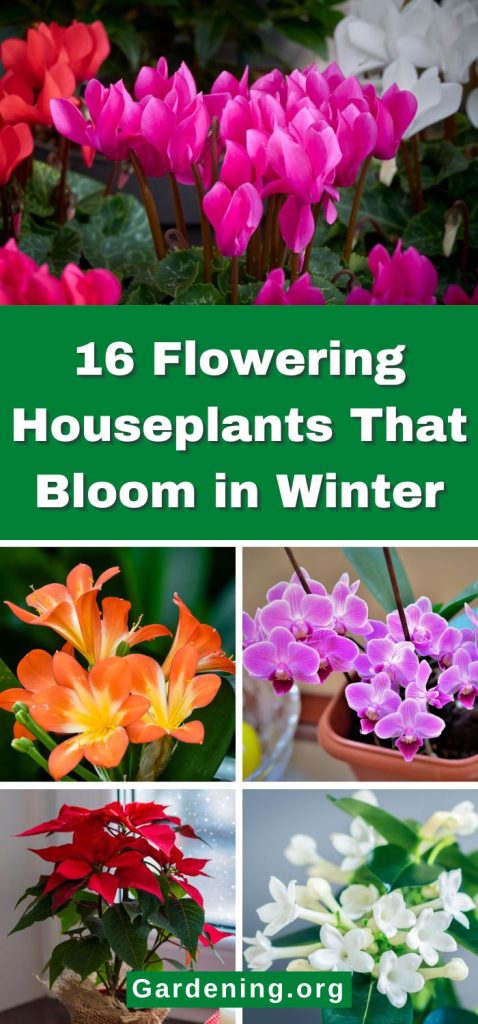
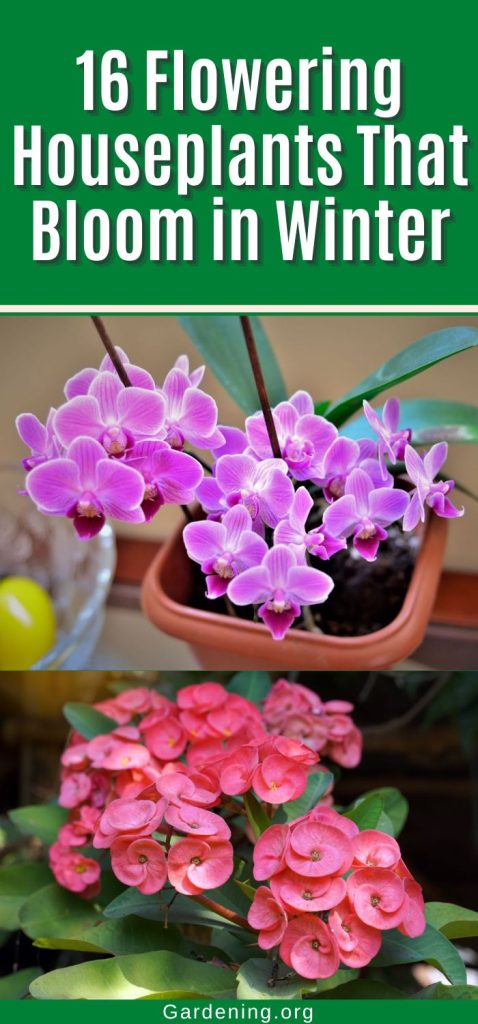
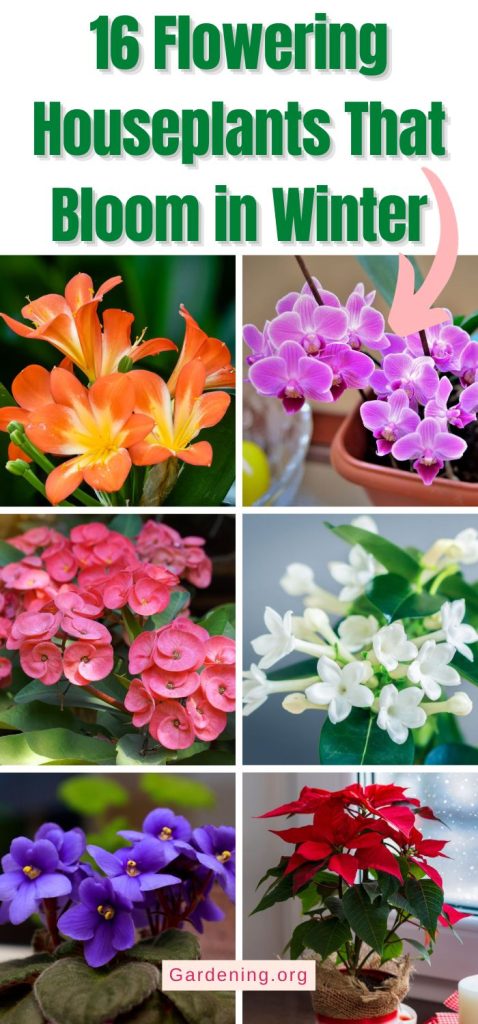
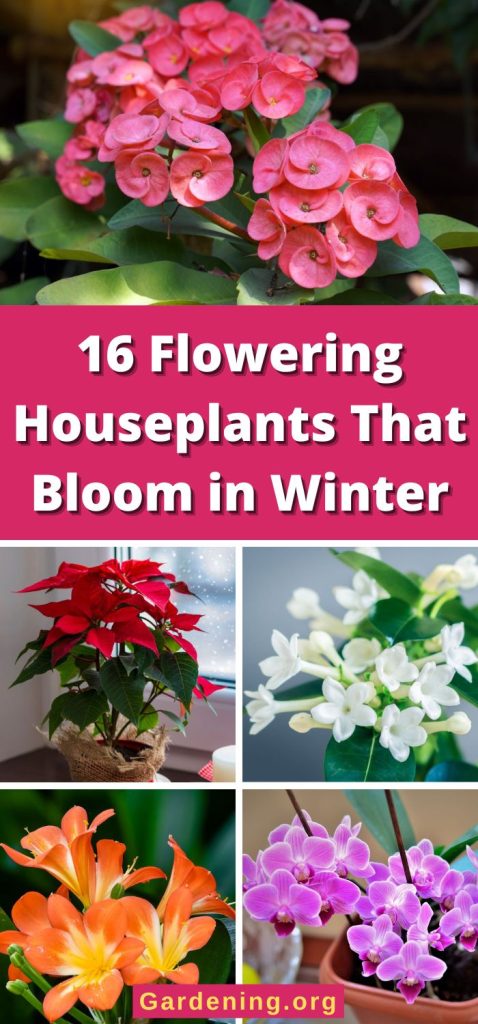
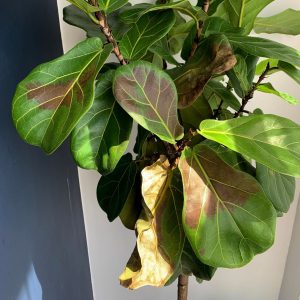
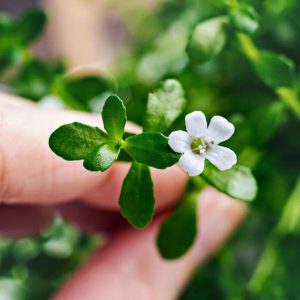
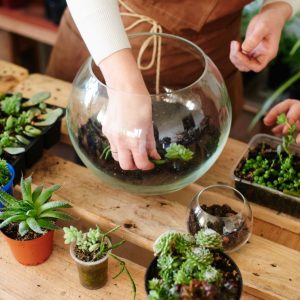
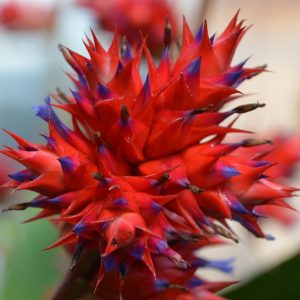
Leave a Reply